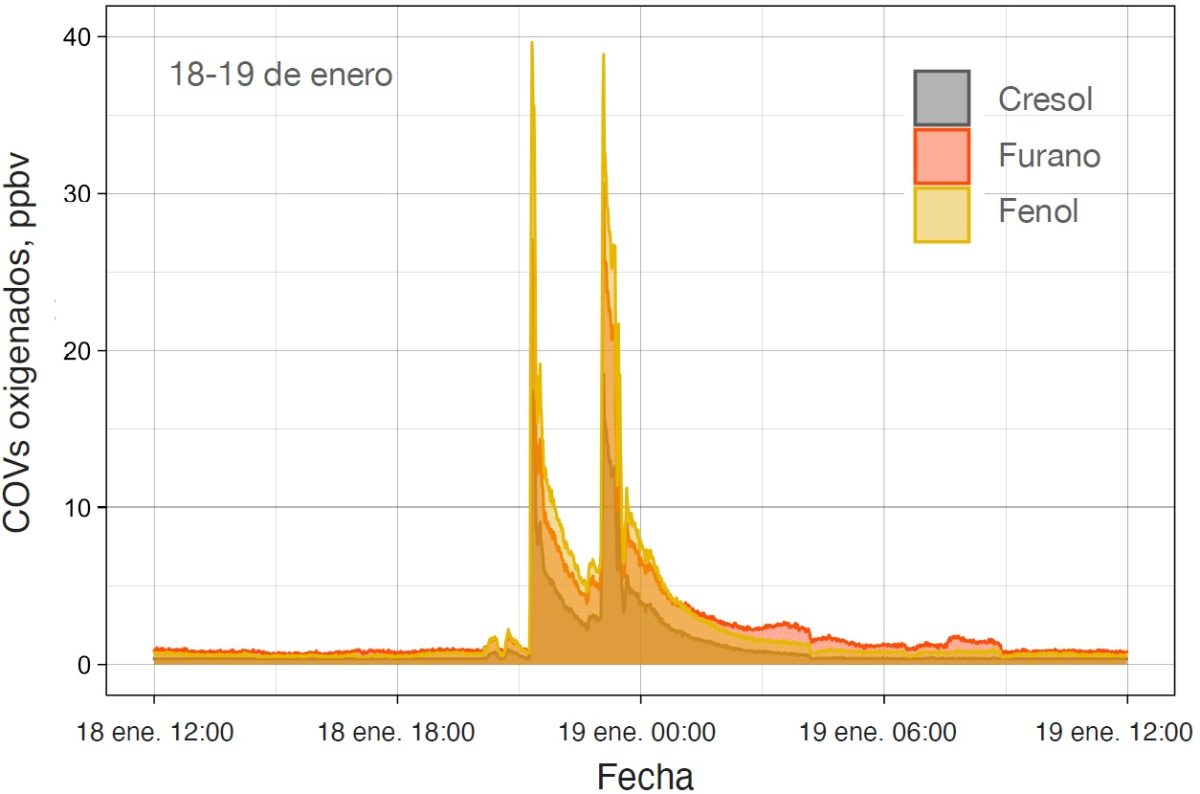By Rodrigo Seguel, Researcher at the Center for Climate Science and Resilience (CR2)
- Since 1955, various productive activities have been concentrated in the Quintero-Puchuncaví area, generating saturation by delicate particulate matter and impacts on human health.
- A study conducted by CR2 showed that certain volatile organic compounds emitted by the industrial processes in the area are associated with the discomforts experienced by residents of Quintero.The industrial hub is not the sole responsible for pollution episodes, as emissions from other industrial sources located south of the bay can reach Quintero due to wind patterns.
Polluted areas with high industrial concentration, also known as sacrifice zones, impose enormous social challenges and represent an unresolved issue in Chile and worldwide. One of these areas is the Quintero-Puchuncaví Bay, which since 1955 has concentrated various activities related to copper smelting, power generation, and storage and distribution of fuels and chemical products. As a result, the Concón-Quintero-Puchuncaví area is saturated with fine particulate matter (PM2.5) and has experienced dramatic episodes for human health associated with sulfur compounds such as sulfur dioxide (SO2). Additionally, in recent years, events related to the liquid and gaseous fuel industry have occurred.
The available environmental management instruments in this bay have not effectively reduced the population’s exposure to dangerous air pollutants. In fact, in 2023 alone, 728 medical consultations have been reported for symptoms associated with the presence of hydrocarbons in the air (Ministry of Health, 2023). For example, in May of this year, 177 cases were registered after high levels of non-methane hydrocarbons (NMHC) reached 6,000 parts per billion in Quintero’s atmosphere, more than 70 times the city’s average value in 2023.
In this regard, it should be remembered that in response to the mass intoxications of 2018, which caused 1,370 emergency care visits (Ministry of Health, 2018), the Ministry of Environment enacted a primary air quality standard for the volatile organic compound benzene (Ministry of Environment, 2023) this year. The objective is to protect the population’s health from exposure to this carcinogenic pollutant, which also affects the immune system.
Therefore, the Concón-Quintero-Puchuncaví area faces several challenges, including implementing and updating this type of highly important management instrument for the community, whose credibility depends, in part, on governance structures and effective stakeholder participation. Currently, these environmental management instruments are the new Air Quality Monitoring Network for the municipalities of Concón, Quintero, and Puchuncaví, the implementation of the primary air quality standard for the volatile organic compound benzene, and the early warning network for the Quintero-Puchuncaví industrial hub.
In this context, the Center for Climate Science and Resilience (CR2) made its scientific and technological capabilities available to the community to understand air quality episodes associated with volatile organic compounds (VOCs) affecting the city of Quintero. To this end, measurement campaigns were conducted in winter and summer periods in 2022 to study unregulated air pollutants and the meteorological regimes that influence the occurrence of air pollution episodes in the Quintero-Puchuncaví Bay. This campaign’s main findings, conclusions, and recommendations are presented below.
Conclusions
The scientific evidence gathered during the first part of the study (summer campaign), conducted between January 4 and 28, 2022, demonstrated that certain VOCs emitted by industrial oil and gas processes in the Concón-Quintero-Puchuncaví area are associated with discomforts experienced by Quintero residents.
In general terms, Quintero experienced good air quality during January. However, this favourable condition was interrupted by high levels of VOCs measured in real-time:
- High levels of light VOCs (propene/cyclopropane, butenes) and aromatics (benzene, toluene, and ethylbenzene/xylenes) emitted from oil and gas processing units under weak northerly and northwesterly winds (i.e., coming from the bay), impacted Quintero, which caused complaints of unpleasant odours (Figure 1).
- High levels of oxygenated VOCs (phenol, furan, and cresols) under strong wind from the southwest also impacted the city of Quintero. Symptoms included headaches and dizziness (Figure 2).
- The industrial hub located in the bay is not the only source responsible for pollution episodes. In this sense, industrial sources located south of Quintero can also transport contaminated air masses due to the prevailing wind from the south.


Recommendations
- Maintain a record of the VOCs co-identified in the routine benzene analysis performed by the monitoring network. This is to provide relevant information for the subsequent review of the national benzene standard, conducted every four years.
- Determine if the alert, pre-emergency, and emergency levels established in the benzene standard are adequate to protect the population from exposure to VOCs.
- Encourage collaboration between state institutions, academia, and the private sector through the articulation of inter-comparison exercises of methods based on continuous and discrete monitoring at the laboratory and field scales. This is to evaluate, improve, and develop VOC-related environmental technologies that ensure quality information.
- Evaluate the consistency between the environmental levels of VOCs and the emission inventories in the Concón-Quintero-Puchuncaví area to mitigate emissions through focused control.
- Optimize the configuration of the Concón-Quintero-Puchuncaví monitoring network according to the complex wind circulation pattern and pollutant transport observed in the area.
- Incorporate long-term measurements of other unregulated organic tracers to ensure transparency and public scrutiny.
References
Decree 83 of 2018 [Ministry of Health]. Decrees a health alert for the specified period and grants the indicated extraordinary powers. September 27, 2018. https://www.bcn.cl/leychile/navegar?idNorma=1123413
Decree 83 of 2023 [Ministry of Health]. Decrees a health alert for the specified period and grants the indicated extraordinary powers. May 27, 2023. https://www.bcn.cl/leychile/navegar?i=1192650
Decree 15 of 2023. [Ministry of Environment]. Establishes primary air quality standards for the volatile organic compound Benzene. May 11, 2023. https://www.bcn.cl/leychile/navegar?i=1192010
